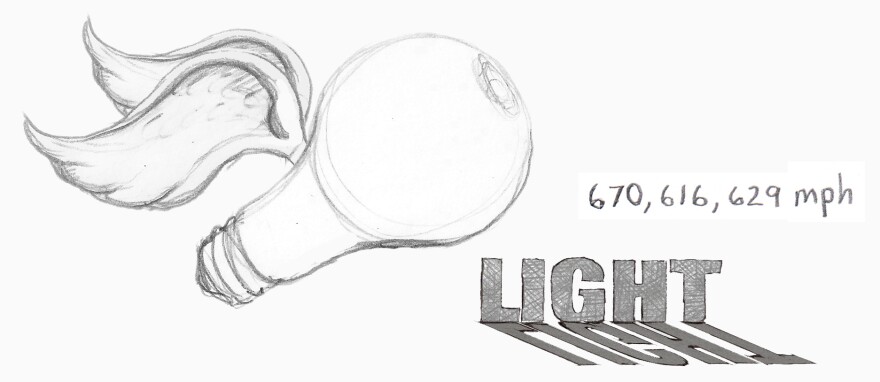Before we go slow, let's go fast, so fast you can't go any faster. That would be light in a vacuum, traveling at 670 million miles per hour ...

Light, of course, can slow down. When light passes through water, it loses speed. A diamond is an even better speed bump. It can slow a beam of light by 40 percent.
But moving on, you and I are going pretty fast right now, though we don't notice. The planet we're on is zipping around the sun at 66,000-plus miles per hour ...

You'd think there would be wind whipping through our hair, but no, we're cocooned by the Earth's atmosphere, so we have no easy way to sense our motion. We could, of course, leave the Earth and watch our planet from a distance, but to do that, we'd have to kick off the surface, and that takes a lot of speed. ...

In fact, getting away from something often requires a speedy ejection. Take sneezing. You breathe in an irritant, say, a prickly dust particle, your body tenses and ...

... out it flies — at up to 104 mph.
You can't run away from something that fast. The fastest runners we have — at full sprint — don't do much better than ...

... 26, 27 mph. That's how fast Jamaican champion Usain Bolt can go. Most of us are content to waddle along at a much slower pace.

... which still makes us much faster than the slowest waddlers, who don't really waddle; snails seem to slide on their own mucus, which makes them icons of slow-ocity. ...

By now we're getting down to truly slow, slow-motion speeds that describe the growth rate of bamboo (1.3 x 10-6 miles per hour), or slower still, this is the average growth rate of a child — expressed in miles per hour.

We can go even slower. The moon is drifting away from the Earth. Three billion years ago it was bigger in our sky, but its retreat is so delicate, you'd never know it was moving unless you painstakingly measure the widening distance.
And even slower than that — as this is as slow as I'm going to go in this post, because you have to stop somewhere — is what's happening at the ends of your fingers and toes. We know nails grow. But in miles per hour, they achieve a kind of Gold Medal of Sluggishness.

But before I conclude, to show you that we're nowhere near the slowest of the slows, I want you to imagine a pile of uranium atoms (think of lots of electrons spinning around a big, fat nucleus). Now, close your eyes, and keep them shut for 4.47 billion years. When you open them, half those atoms will no longer be uranium. They will have decayed into something else. Their rate of decay, their "half life," 4.47 billion years, is roughly the age of our planet. Talk about slow. That's really slow.

I got these numbers from a chart labeled "Speed" in David Blatner's new book, Spectrums. I know I've been cribbing off of Blatner a lot this week, but that's because his little volume about scaling is so provocative. He just gets me thinking.
Copyright 2021 NPR. To see more, visit https://www.npr.org.




